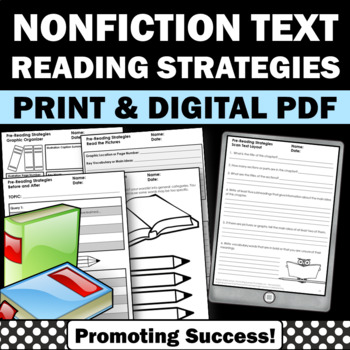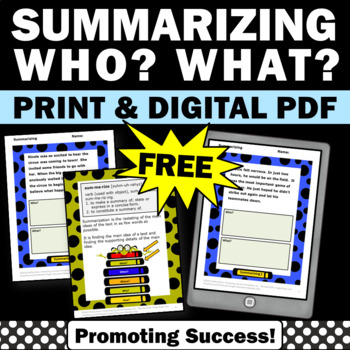Click HERE to SUBSCRIBE to our V.I.P. Promoting Success teacher newsletter for SECRET SALES and FREE printables.
Click HERE to SUBSCRIBE to our Printable Art newsletter for SECRET SALES and EXCLUSIVE COUPONS.
Click HERE to follow us on Instagram.
Click HERE to follow us on Facebook.
--------------------------------------------
From Doing What Works...
Teach students how to use several research-based reading comprehension strategies.
Good readers use comprehension strategies including activating prior knowledge or predicting, questioning, visualizing, monitoring, drawing inferences, and retelling. Children should be explicitly taught these strategies, have them modeled by the teacher, and be given opportunities to practice them with guidance and independently.
Teach reading comprehension strategies individually or in combination.
Teaching reading comprehension strategies, whether one by one or in combination, improves children’s reading comprehension. Single-strategy instruction provides time for students to practice each strategy for a period of time before the next strategy is introduced. Multiple-strategy instruction introduces several strategies simultaneously to be practiced in combination. This approach helps readers learn to use strategies together from the very beginning, providing a more authentic reading experience.
Teach reading comprehension strategies by using a gradual release of responsibility.
A gradual release of responsibility involves teachers first explaining and modeling a strategy, then giving students more and more independence in practicing and applying the strategy over time.
Teach reading comprehension with multiple genres of text.
Teachers should introduce both literary and informational text to their students when teaching reading comprehension. Literary texts include narratives, which portray a story, or a sequence of related fictional or nonfictional events involving individuals or fictional characters, and poetry. Informational texts analyze or describe factual information about the natural or social world.
Choose high-quality texts of appropriate difficulty.
Teachers should choose texts carefully and consider both the content quality and difficulty level. Difficulty is defined by the text demands (e.g., decodability of the words, complexity of the sentences) and content demands (e.g., how complex, subtle, or abstract the information is).
Use texts that support the purpose of instruction.
Reading comprehension instruction serves many purposes, and the text used should fit the purpose of instruction. For example, lessons on text structure begin with a text about a familiar topic in which the structure is easy to identify. When teaching students to make predictions, select a text that is unfamiliar to students or one in which many outcomes are possible.
-----------------------------------------------
You may also like these resources from our TpT store:
-
- -------------------------------------
- You may also like these reading resources from our Amazon Associate store:
-
-
- -------------------------------------Click HERE to SUBSCRIBE to our V.I.P. Promoting Success teacher newsletter for SECRET SALES and FREE printables.Click HERE to SUBSCRIBE to our Printable Art newsletter for SECRET SALES and EXCLUSIVE COUPONS.Click HERE to follow us on Instagram.Click HERE to follow us on Facebook.Shelly Anton is a participant in the Amazon Services LLC Associates Program, an affiliate advertising program designed to provide a means for sites to earn advertising fees by advertising and linking to Amazon.com. ** This means there are Amazon affiliate links in these blog posts. This does not mean you pay a dime more when you purchase a product through the link. It just means I am trying to save you valuable teacher time by making it easier for you to find valuable resources for your students, and I earn a few cents for my research and time. Thank you for all you do for kids!







No comments:
Post a Comment
Please leave a comment below. Thank you!